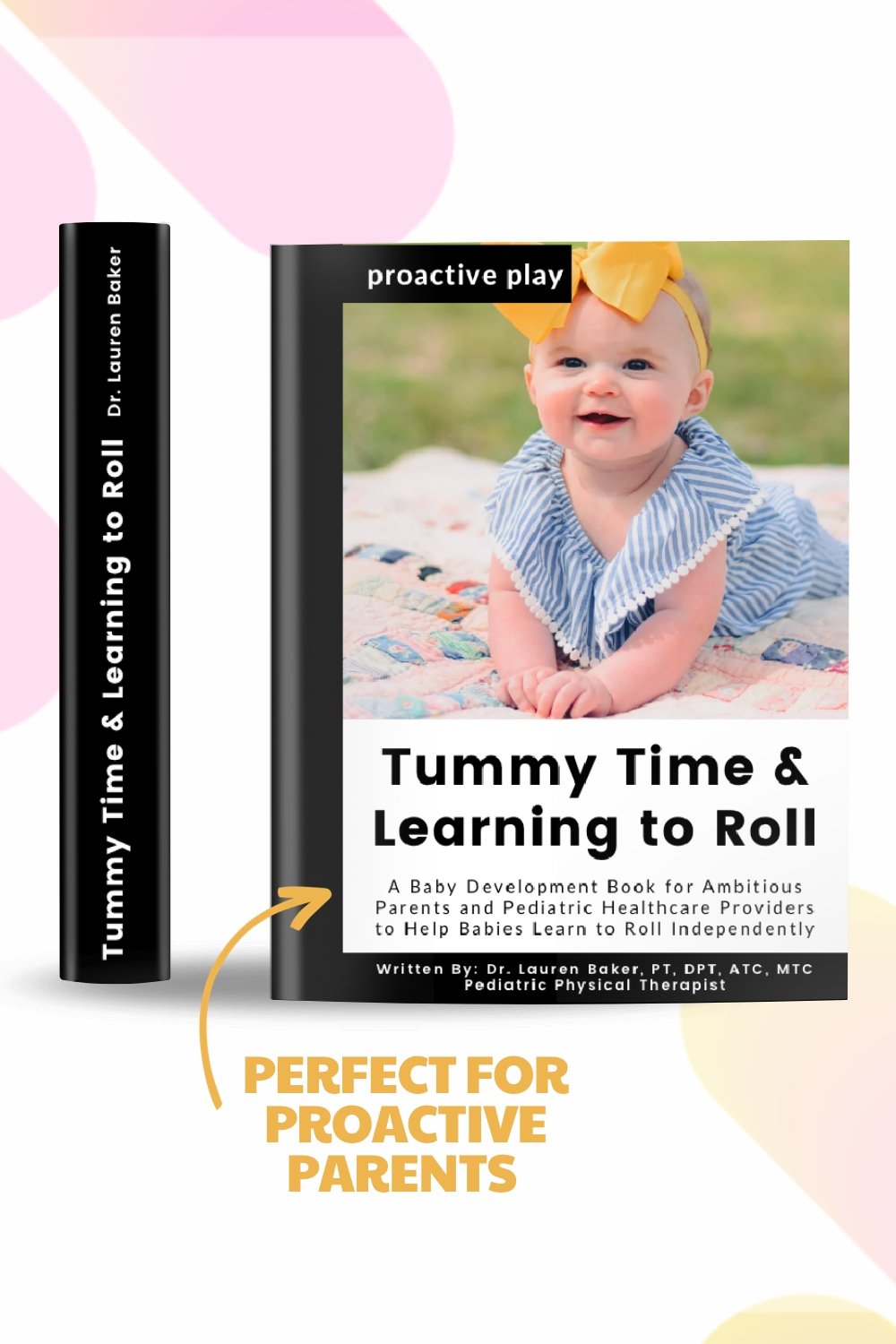Baby Tornado: The Fun Exercise to Get Your Baby Rolling!
Welcome to the world of baby rolling, where you’ll be introduced to a fun, effective exercise called the "Baby Tornado." I'm Dr. Lauren Baker, a pediatric physical therapist and author committed to helping proactive parents like you help your baby move better. If you're diving into Google and YouTube searching for answers on how to help your baby roll, fear not! You're more capable than you realize – and all you need is a dash of knowledge and a whole lot of courage to get started.
Why Rolling Is a Big Deal
Rolling might not get the attention it deserves, but it's a critical milestone for your little one. Babies typically master rolling belly to back from three to five months of age and from back to belly from four to six months of age.
Rolling is a complex movement pattern because it is one of the first times babies learn to move their upper and lower trunks separately. Imagine sitting and reaching behind you to grab something off a shelf or table but without moving your pelvis – that is moving your upper half of your body on the stabilized (non-moving) lower half of your body. These motions – moving one part of the body but not the other – are important for complex movement.
When babies roll, it teaches them how to move one part of the body without the other, while lying on the ground. This is the first step for them to learn so they can then master it in sitting once they get to crawling age (it’s how the get in and out of sitting, too!).
Babies should roll from their back to their belly in both directions—right and left. If a baby consistently favors one side, it might be due to a restriction in the opposite direction. Asymmetry can lead to issues down the road, so helping your baby roll in both directions is essential.
The Benefits of Rolling for Babies:
Core Strength: Rolling involves complexity in how the muscles work together, particularly in the core (muscles that cover the front, sides, and back of a baby’s trunk). It's one of the first instances where your baby learns to engage and strengthen these crucial muscles in a moving position and not just stationary. This forms the foundation for later milestones like crawling and sitting up.
Spatial Awareness: Rolling teaches your baby about where their body is in space. As they figure out how to transition from their back to their belly and vice versa, they're also learning to navigate their surroundings and learning how they play a role (or roll) in them.
Independence: When babies can roll by themselves, they gain a sense of autonomy and control over their movements. It's an essential part of their journey towards becoming mobile.
Problem Solving: Rolling isn't as straightforward as it seems. Your baby needs to figure out the coordination required to make it happen. This early problem-solving experience lays the groundwork for more complex motor skills later on.
Development of Muscle Balance: Rolling helps your baby balance the use of different muscle groups on each side of their body. This balance is crucial for overall motor development and balance for when they transition to sitting, standing, and walking.
The Baby Tornado Recipe
Before we dive into the tornado technique, ensure your baby has full head control, typically around four to five months. If they're younger or they do not have full head control, you will have to support their head with your hand.
In the video, you'll see me demonstrating the Baby Tornado with two little ones—one around five months and the other closer to eight or nine months. Each baby has its unique challenges, so don't worry if it takes some practice!
For 4-5 month old babies:
Lay your baby on their back facing you with open space going to your right
Place your right hand on the front of what will be the bottom hip (the baby’s left hip) and your left hand (forming a C shape) underneath their right buttocks,.
Flex their right hip from the booty and rotate them over.
You may have to use your left hand onto the back of their left upper back to help go from side to belly if they are not pushing through their left arm to help
Tuck their elbows once they're in tummy time or prone and provide support if needed to keep elbows in place.
For 5-6 month old babies:
Lay your baby on their back facing you with open space going to your right
Place your right hand on the front of what will be the bottom hip (the baby’s left hip) and your left hand (forming a C shape) underneath their right buttocks,.
Flex their right hip from the booty and rotate them over.
Encourage them to push up on their elbow and pivot into prone position.
You may have to shift their pelvis down and toward the right to untuck their left arm
Tuck their elbows once they're in tummy time or prone.
Provide shoulder support in tummy time if needed
Baby Tornado Exercise with an 8-9 Month-Old Baby:
Place your baby on a playmat about four to five feet away from their toy.
Start with the baby on their back and guide them through rolling.
Gently block their shoulder and tuck it under to help them roll from their belly to their back
The baby should be able to control their head and push through their elbow to get from back to belly and belly to back, so you may only need to support at the hips.
Encourage three to five rolls in each direction.
The baby tornado and everything that I have learned in over 10 years as a Physical Therapist are located in the Tummy Time and Learning to Roll: A Baby Development Book for Ambitious Parents and Pediatric Healthcare Providers to Help Babies Learn to Roll Independently. To purchase or learn more about the book click here: https://amzn.to/3Q8dg5U
Curious about learning more on Tummy Time, Rolling, or Both?
The absolute best book for parents on tummy time and rolling is: Tummy Time and Learning to Roll: A Baby Development Book for Ambitious Parents and Pediatric Healthcare Providers to Help Babies Learn to Roll Independently. The book comes with a free online video course to help parents fully understand how to complete the different exercises, printable checklists to know exactly where your baby is at, and when to reach out for additional help.
This book was written by Dr. Lauren Baker, PT, DPT, ATC, MTC, who is a Pediatric Physical Therapist in Boise, Idaho, trained in helping parents learn how to help their babies move and master their milestones. She loves teaching parents how to see how their babies are moving as well as how to influence those movements though play positions and exercises to help babies move with confidence and ease.
Tummy Time and Learning to Roll is the first book in the Proactive Play series written by Pediatric Physical Therapist Dr. Lauren Baker in order to help Ambitious Parents and Pediatric Healthcare Providers learn how to help babies master tummy time and learn to roll. It is meant to help ambitious parents understand baby development from birth to six months (tummy time to rolling).
This book is a mix of easy-to-follow and more in-depth information than is typically found in baby development books because Dr. Baker believes parents deserve to have all the information at their fingertips.
This book breaks down each piece of movement in checklists so that parents know what their babies need for tummy time and rolling. It also covers what areas might limit a child with rolling, why it is so important, and when to seek help from a pediatric PT.
This book comes with colored photos and easy-to-follow demonstration videos that can help parents implement safe, strategic play-based exercises with their babies in 20 minutes per day.
A Great Resource For:
Parents and Pediatric Healthcare Providers of babies 0-6 months
Parents of babies who are struggling with tummy time, rolling back to belly, belly to back, or only to one side
Access to simple, easy-to-follow videos of play positions and exercises
Learning the four pillars of movement needed in order to master rolling
240+ Color Photo Examples of:
Tummy Time, Sidelying, and Back Play
Developmental Toys and Equipment
Hand Placement and Strategic Play Positions
Common Areas of Restriction or Weakness
When To Reach Out For Help
What If You Need Extra Help?
If your baby is struggling with rolling or you have concerns about their movement, remember, you can always reach out to a pediatric physical therapist. It's your right as a parent to advocate for your child's development. Sometimes, a few tips and tricks are all you need to get your baby moving better. We're here to support you and release those mama worries.
If you have any questions or want to schedule an online parent consultation with me, you can schedule anytime by clicking to the appointment tab or by clicking here. Or, consider reaching out to a local pediatric physical therapist who can provide insights and guidance.
Let’s embrace the adventure of babies learning to roll and help your little one conquer this exciting milestone! 👶🌟



